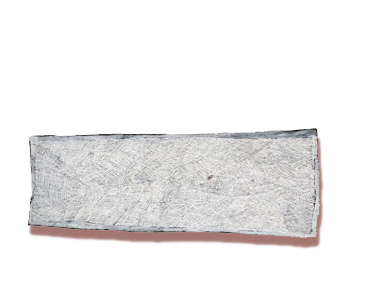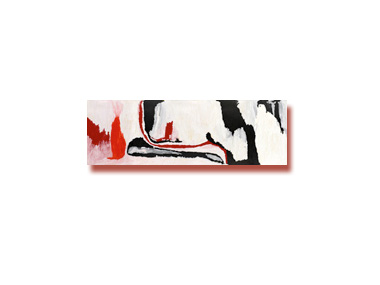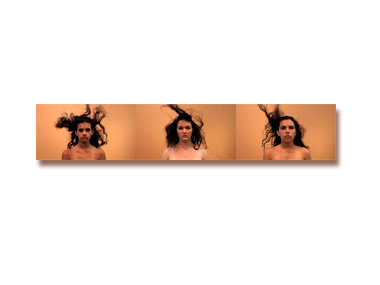SECOND INDIGENOUS TRIENNIAL

Nyapanyapa Yunupingu, Gumatj people, 'White painting 2', 2010 Natural earth pigments on bark, NGA © the artist, courtesy Buku-Larrnggay Mulka Centre
Posted by Jeremy Eccles | 23.05.12
Gallery: National Gallery of Australia
Dates:
12.05.12
: 10.07.12
Why did the word 'colourless' spring to my mind when trying to sum up the National Gallery's second National Indigenous Art Triennial?
I think the answer intrinsically springs from the diminished role played by vibrant Desert art. Yes – there's Naata Nungurrayi's cheerful orange; there's Daniel Walbidi's fantastic fusing of desert colours in the yellow spectrum with the blue/green of his seaside home south of Broome; and there's a stand-out Sally Gabori canvas where a brilliant orange square is broken in just one corner by an intrusion of black.
But there's nothing from those dynamic APY Lands – the source of current rival exhibitions from Perth to New York; home of the winners of the last two NATSIAA prizes; and the fount of an exuberance and spiritual complexity that would perhaps have challenged curator Carly Lane's decision to opt for a 50/50 division of her twenty chosen artists between the remote and the urban. For it is to the greater benefit of the sensibility of the Blak half of the show that seriously grey walls were chosen as its backdrop – causing the dramatic subtleties of that marvellous Arnhem artist Gunybi Ganambarr to almost disappear into the gloom.
Meanwhile, the angry politics of the proppaNOW duo of Vernon Ah Kee and Tony Albert shout above the umbra, and the more subtly sorrowing works of Julie Gough and Fiona Foley are emoted by the grey. In the middle, the equilibrium offered by Danie Mellor and Michael Cook reflects what Mellor calls in the catalogue “the complexity of our shared history”, revealing an intellectual sensibility that leaves space for wit, provocation, aesthetic delight and sensuality – as well as eye-catching flashes of colour in the form of rainbow lorikeets (Mellor) and Redcoats (Cook).
Michael Cook gets the catalogue cover and deserves it – using 25 years of commercial photographic experience in his technically brilliant creations. The messages are more mixed. While his Aboriginal male protagonists are masters of a shore threatened by invasion, his gorgeous female equivalent gets stripped of her wigs and finery and enslaved.
Compared to the first Triennial in 2007, this is a much more political event. From the NGA's appointment of Carly Lane as the outside Indigenous curator to the choice of 'diversity' as her prevailing theme, there was little room to avoid a show that tends to prove that anything can be called 'Indigenous art' - from Alick Tipoti's outsize witch-doctors' masks from the Torres Strait, via Jonathan Jones's light-bulb installation and the Yarinkura/Burruwal team's fibre sculpting to Christian Thompson's film of Hetti Perkins's daughters staring proudly from the screen as a 'desert' wind blows their hair; pity it failed to conjure Botticelli's Venus for me, as the catalogue said it should. Instead, I'm afraid it recalled John McDonald's recent review of Janet Lawrence's eco-installation at the Sherman Contemporary Art Foundation, which concluded: “We are looking at the elephants and pandas, not the art. The art itself is the least important part of the package”.
So at the Triennial we are looking at a package designed to “challenge expectations”, bring the Indigenous story “up to date”, engender “sadness and anger”, recall “the hard times and fourth world conditions we live in”, and “confront without being controversial”. These are all phrases from Carly Lane's introductory tour of her show when it opened. And they're really all referring to her urban half of the show – which is so much easier to talk about than the hard-to-disclose remote part of a show challengingly entitled 'unDisclosed'.
And yet someone like Sally Gabori has such a poignant story to tell – in life and her art, which is her only way of revealing the social history and spiritual depths of her Bentink Island homeland when she speaks a language now only understood by about half a dozen people in the world. It's sad to have to turn to the catalogue, away from the art, to get just an inkling of it.
But at least she's still alive at 90 and still capable of dancing for her paintings at the opening. The two year delay – one year because so much effort had gone into opening the new Indigenous galleries, and a second because the NGA claimed it was too poor to put this show on – might well have seen her pass on. Judging from Gabori's recent show in Sydney, her art is in the process of passing on. While in Canberra, she competes with Nyapanyapa Yunupingu for the most outstanding painting in the show. On the other side of the timeline, it must have seemed especially attractive for the Perth-based Lane to introduce the virtually unknown Nyoongar, Lindsay Harris to the Eastern two-thirds of the Indigenous art world. But his recent show in Singapore evidences such an advance in his earthy art, one wishes there could have been greater flexibility in its selection.
Carly Lane's last room was intended, she said, to impose the most intense memories on viewers as they leave 'unDisclosed'. This would then have been a match for impressions on the way in of Lorraine Connelly-Northey's ample rusting ironwork map of her Country and Alick Tipoti's beady-eyed crocodile shark mask. To the unseen sounds of Christian Thompson's twangling harp, the first sight in Room 5 is Tony Albert's 'Pay Attention Mother Fuckers'. Whoa! Are we into post-Modernism here! For the original borrowing is from the American Bruce Nauman's black and white 1973 lithograph – helpfully (but distantly) on display on your way into the exhibition. I wonder what he intended? Albert, on the other hand, has gone all out to satisfy the diversity branding of the show by collaborating with as many indigenous artists as there are letters in his mirror-image duplication of the title – each one decorated differently. It's big, it's bold, it's a rude challenge; but the art itself is the least important part of the package.
It's also capable of overshadowing the work that stimulated me most in the Triennial. Nyapanyapa Yunupingu has excited almost since she emerged from that most traditional of worlds around the Buku-Larrnggay Art Centre at Yirrkala in NE Arnhemland. Her first efforts were pure story-telling from her own life on bark; then she threw in a video explaining her stories which stole the new multi-media Telstra prize from under the noses of urban entries that must have thought they'd waltz in; and now she seems to me to have magically decided to do what white art commentators have been trying to impose on Aboriginal art ever since Emily Kngwarreye first painted. She's set out to create an Abstract Expressionist vision – on that most realistic of media, bark – by scratching a profusion of white lines on to her eucalypt canvas, with just a hint of the old discipline and zing of rarrking. Art Centre Director Will Stubbs has then compounded the picture by entitling her works, 'White Painting'.
Brilliant! And colourless! Come in Robert Rauschenberg.
URL: nga.gov.au
Share this:
»  del.icio.us
»
del.icio.us
»  Digg it
»
Digg it
»  reddit
»
reddit
»  Google
»
Google
»  StumbleUpon
»
StumbleUpon
»  Technorati
»
Technorati
»  Facebook
Facebook
Contact Details
Gallery: National Gallery of Australia
Contact: Tina Baum - Curator Aboriginal and Torres Strait Islander Art
Telephone: +61 2 6240 6502
Address: Parkes Place or GPO Box 1150 Canberra ACT 2601 Parkes Parkes 2601 ACT
Gallery: National Gallery of Australia
Contact: Tina Baum - Curator Aboriginal and Torres Strait Islander Art
Telephone: +61 2 6240 6502
Address: Parkes Place or GPO Box 1150 Canberra ACT 2601 Parkes Parkes 2601 ACT

Mirdidingkingathi Juwarnda Sally Gabori, Kaiadilt people, 'Nyinyilki', 2009 Synthetic polymer paint on canvas. NGA © the artist, courtesy the artist

Christian Thompson, Bidjara people, 'HEAT' 2010, 3-channel video on loan from artist and private lender
Where is the exhibition?
Further Research
Gallery: National Gallery of Australia
Artists: Alick Tipoti | Bob Burruwal | Christian Thompson | Danie Mellor | Daniel Walbidi | Emily Kngwarreye | Fiona Foley | Gunybi Ganambar | Jonathan Jones | Julie Gough | Lena Yarinkura | Lindsay Harris | Lorraine Connelly-Northey | Michael Cook | Naata Nungurrayi | Nyapanyapa Yunupingu | Sally Gabori | Tony Albert | Vernon Ah Kee
News Tags: Aboriginal & TSI Art | Carly Lane | Indigenous Triennial | National Gallery of Australia
News Categories: Australia | Blog | Exhibition | Feature | Industry | News
Exhibition Archive
- 10.10.17 | TARNANTHI 2017
- 11.08.17 | Natsiaas 2017
- 20.07.17 | APY ART DOMINATES THE WYNNE
- 17.07.17 | Anangu Artist Wins $100,000 Prize
- 14.07.17 | The End of AAMU
- 11.07.17 | ART ACROSS THE COUNTRY
- 11.07.17 | TARNANTHI IN OCTOBER
- 05.07.17 | TJUNGUṈUTJA - from having come together
- 13.06.17 | Ghost-Nets Straddle the World
- 07.06.17 | Grayson Perry Going Indigenous?
- 05.06.17 | Barks Bigger than Ben Hur
- 27.05.17 | NGA QUINQUENNIAL 2017
- 21.05.17 | Blak Douglas Finds Home at the NGA
- 21.05.17 | BRIAN ROBINSON WINS HAZELHURST WOP
- 18.05.17 | PARRTJIMA 2.0
Advertising

